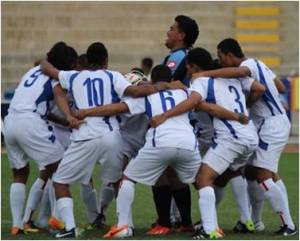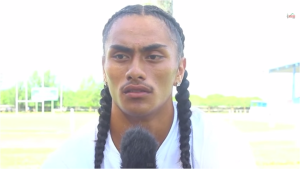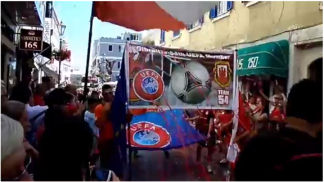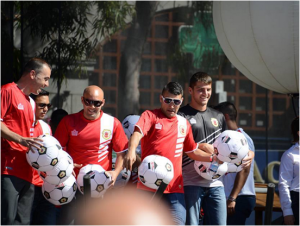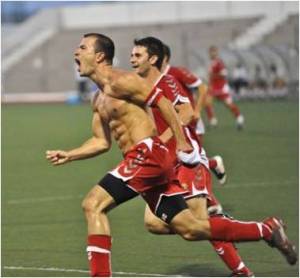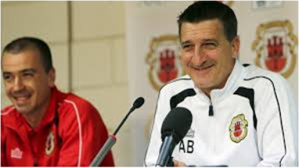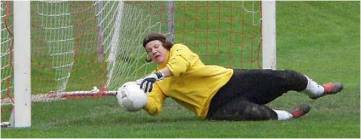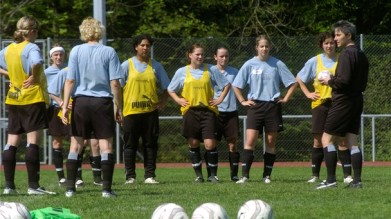[Note: this interview was conducted in June 2013 for TQM Magazine.]
As Torquay United’s season reached a crucial point in their battle against relegation, I caught up with midfielder Craig Easton, currently in his first season at the club, to discuss his career so far and plans for the future.
Craig Easton is not your stereotypical professional footballer. While at Livingston in 2004, he confessed to the club’s matchday programme, “It sounds really boring, but I am quite into my gardening”. He’s also articulate – in 2012, he wrote a 10,000-word essay entitled The Future of Scottish Football, exploring his country’s tactics and youth coaching.
His off-field hobbies differ from those of his Torquay United team-mates, then, and so does Craig’s CV: with over 250 appearances in the Scottish Premier League (the country’s top division, commonly known as the SPL) and having captained Scotland at under-21 level, the midfielder is a pretty high-profile signing for fourth-tier Torquay.
In a way, it’s not surprising Easton has enjoyed a successful career in football: born in Bellshill, near Glasgow – the same place as footballing greats Sir Matt Busby, Ally McCoist, Billy Shankly and Jock Stein entered the world – Craig also comes from a family of footballers. His father represented Livingston United at junior level, while his brother, Stewart, has played for Airdrie and Elgin City.
Craig started his career at Dundee United, graduating from the club’s successful youth team in 1996. A league debut followed soon afterwards, and as early as July 1997 he was representing Dundee United in international competition. Craig’s first UEFA Cup game couldn’t have gone better: a 9-0 trouncing of Andorran minnows CE Principat in which he came on as a substitute.

Easton (left) scoring for Leyton Orient against Fulham
Easton continued to make a name for himself at Tannadice in the following years, and was a regular in the starting line-up from 1997 until his departure in 2004. That departure was brought about by the arrival of Ian McCall as manager, whose reign saw Craig somewhat fall out of favour.
By late 2003, the midfielder had decided not to sign a new contract with the club when his current deal expired, and in April 2004 McCall confirmed that Easton was free to leave at the end of the season. Of course, McCall’s verdict was irrelevant; as Craig himself said at the time, “It was clear I wasn’t going to be in the manager’s plans, so when the club said they didn’t want to offer me a new deal, it came as no surprise.”
However, the news did upset many supporters, and a May 2004 statement on the club website paid tribute to his popularity: “News that Craig Easton is to leave the club at the end of the season has sparked a flood of mail in appreciation of his contribution to the club, both on and off the park…Off the park, he has attended countless events on behalf of the club and has always been amongst the first to volunteer to help out when required.”
United’s SPL rivals Livingston offered a fresh start, and Easton immediately justified the club’s interest in him by scoring on his debut against Inverness. He went on to play in 30 of Livingston’s 38 league games, even scoring the crucial goal that saved them from relegation on the last day of the season – sending Dundee, his first club’s rivals, down at Livingston’s expense.
Despite this, Livingston declined to renew Craig’s contract, and he spurned interest from mid-table Motherwell to move south and join Leyton Orient of the English fourth division. It was there that Easton would meet Martin Ling, then Orient’s manager, who would eventually bring the player to Torquay in 2012.
His first season in England couldn’t have gone better. Almost ever-present in the league as Orient won promotion to League One, the third division, on the last day of the season (with Craig scoring again), Easton also opened the scoring at Craven Cottage as Orient pulled off a huge shock to knock Premier League Fulham out of the FA Cup in January 2006. Unsurprisingly, it meant a lot to Craig, who revealed after the match, “I would put that down as my greatest achievement and my most enjoyable moment in football so far.”
Easton’s appearances the following season were slightly decreased, playing two-thirds of Orient’s games in League One, and in June 2007 he opted to join Swindon Town of the same division. His first season with the Robins yielded his highest ever goal tally for a single season – six goals in League One. However, it was a similar story to at Orient, as Craig’s second campaign saw him used more sparingly and in a variety of positions. He made fewer appearances still in 2009-10, and at the end of the season he rejected a new deal with Swindon.
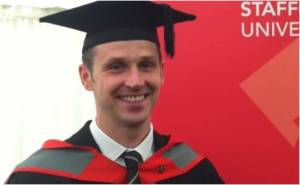
Graduating from Staffordshire University
It was while at the County Ground that Craig was approached by the editor of a newspaper in Scotland to write a column about his life as a footballer. Although the editor initially planned to ghost write the column himself – as is often done when journalists interview players for similar features – Craig asked for the opportunity to practice his writing skills, and this step would eventually lead to his enrolling on a Journalism and Broadcasting degree course at Staffordshire University. He would graduate from the course with a first-class honours degree.
Craig subsequently signed for Southend United, immediately being named club captain, scoring his first Shrimpers goal shortly afterwards against Wolverhampton Wanderers in the League Cup. It was a return to regular playing time, with 38 appearances in all competitions, but at the end of the 2010-11 season the player rejected a reduced contract and found himself a free agent once more.
What followed was a return to Scottish football after six years away, but unfortunately Easton’s six-month deal with Dunfermline Athletic was not a homecoming to remember. Struggling with injuries, Craig managed just three games for Dunfermline before his contract ended in January 2012.
Many players would no doubt have been disheartened by such a downturn of fortunes, but Craig continued to search for a route back up the football ladder, and, thanks to their Leyton Orient connection, was handed a two-week trial by Torquay boss Ling towards the end of the Gulls’ successful 2011-12 campaign.
Easton impressed sufficiently to be awarded a permanent deal in June 2012, with Ling hailing the 34-year-old as “the ideal type of character for our squad. He was a massive part of my successful time at Orient…I just know I can trust him.”
Adapting well to life on the English Riviera, Craig was a mainstay in the Torquay side early in the season, and helped the club to a comfortable mid-table position by Christmas, with the play-offs firmly in sight.
However, things took a turn for the worse after Ling was forced to return to London to recuperate from a mystery illness early in 2013, leaving the club to slide down the table under assistant manager Shaun Taylor before Alan Knill was appointed caretaker manager in late February. Torquay struggled to stay in the division, only securing their safety on the last day of the season against Bristol Rovers.
Craig was unable to help his team-mates in their relegation battle as much as he would have liked towards the end of the season – owing to a calf injury that kept him on the sidelines since March – and he was released by Ling’s successor Alan Knill at the end of the season. The midfielder will now look for his eighth club of a distinguished career, and it will be interesting to see what follows when he eventually hangs up his boots: will he pursue a career in journalism or coaching?
********
Craig generously gave up his time to answer my questions about his career and plans after retirement.
Which has been the highlight of your career: scoring against Fulham, captaining the Scotland under-21s, winning promotion with Orient, or something else?
I’m really proud of all the highlights you’ve mentioned. Captaining my country is very special and something I’ll never forget. I’ve got to say that winning promotion with Orient is the greatest achievement in my career. The atmosphere in that game was amazing, and to do it in front of my wife and both our Mums and Dads just made it one of the best days of my life.
What are the best and worst parts of being a professional footballer?
The best part is a bit of a cliché; doing something I love and the only thing I ever wanted to do since I can remember. I absolutely love being a footballer. However, I don’t think people really understand what really goes on, especially at our [Torquay’s] level. There’s no financial security, and that’s more of an issue as you get older. Football’s a profession where how hard you actually work doesn’t necessarily reflect how you’re treated by those in charge.
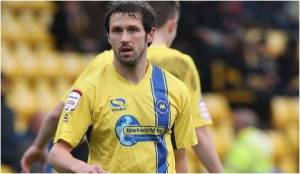
At Plainmoor in 2012-13
Do you have any funny anecdotes you can share from your time in football?
Dave Bowman [Craig’s team-mate at Dundee United] was one of the funniest/maddest players I’ve ever played with.
He enjoyed having ‘banter’ with the cleaning ladies Rose and Ann. One day we returned to find Rose, stuck in a bin with her legs and arms sticking out the top and Bow trying to roll her down the corridor. Another time we found her inside one of the industrial dryers in the kit room with Bow threatening to turn it on. I know this might sound harsh, bordering on harassment, but it was hilarious and wee Rose was a great sport.
What is the best game you have played in? The worst?
It’s difficult to narrow down a single game, so I’ll give you a top 3 in no particular order. Dundee United v Aberdeen in the semi final of the League Cup was one of my first games when I broke into the Dundee United first team as an 18-year-old. I scored my first professional goal and we won 3-1. There’s two Leyton Orient games that stick out: the promotion game against Oxford and also the FA Cup game against Fulham when we won 2-1 at Craven Cottage.
My worst game? There’s too many to mention! Probably any game where I’ve picked up an injury.
How many more years do you want to play for, and do you see your future in journalism or coaching after retirement?
I would say as long as I feel fit enough I’ll keep going and barring the little injury I’ve got at the moment, I feel as fit as at any point in my career. I would love to stay in football. I want to coach and ultimately manage at the highest level possible. I’ll always write, so an ideal scenario would be to continue writing about football whilst managing.
What made you study journalism at Staffordshire University? Did you consider becoming a journalist as a teenager?
I never really considered doing anything other than playing football, although I did well in my exams at school. I suppose, looking back on it now, English was one of my favourite subjects and I did like writing, so I’m not surprised that I’m enjoying the print side of journalism the most. At Swindon, I was approached to do a ‘Diary of a Pro’ piece for the Airdrie & Coatbridge Advertiser, my local paper back home. I asked if I could have a go at writing it myself; I really enjoyed it and things just snowballed from there. I then managed to get on the PFA [Professional Footballers’ Association] course a couple of years later.
Was there a mix of footballers and normal students on your journalism course? If so, how did the other students react to having professional players on their course?
We did a similar degree to other students, although we crammed it into two years and our classes were separate. That was because most of our work was done on a distance learning basis. There were about 15 of us in the class, either pro footballers – mainly from the lower divisions – or ex-players. We attended Uni in Stoke once a month and for a week in the close season before the beginning of each semester to do most of the practical work. We very rarely crossed paths with the other students, but I did meet one who’s a fellow Scot and we’ve become really good friends and are currently working on a project together.
How have your team-mates reacted to your slightly unusual hobbies for a footballer off the pitch (gardening; writing)? Are there any other budding writers at Torquay?
I’m not sure they knew about the gardening until now! I’m not into it as much as I used to be because I’m living in a rented property, but I love being outdoors and going for walks and swimming in the sea. I got a wetsuit for my birthday because it got a bit cold in the winter. That’s what I like about living here – it’s a very outdoorsy area.
[Torquay defender] Aaron Downes is a good writer. He was in my class on the course and we’re hoping to maybe work on something together in the future.
What are the differences between life in Torquay and life in Scotland?
Obviously the temperature’s a bit different to start with! The amount of rain we’ve had down here in the last year has made me feel right at home, though. It’s a very similar sort of lifestyle, especially compared to when I lived in Dundee. I love being close to the sea and going for walks and exploring the area. There are so many lovely places to visit, and Dartmoor reminds me a lot of Scotland. I know this area pretty well as we used to come to Devon and Cornwall most summers when I was growing up. My Dad used to drive down with the caravan – it used to take us 12 – 14 hours! My first ever holiday with my wife was when we went to Torquay on the bus together as teenagers. I have a great affinity with this part of the country.
What were you like as a teenager at school?
I was hardworking and enjoyed some subjects more than others – P.E., Physics, Economics and English were some of my favourites. I didn’t hate it, but I couldn’t wait for it to be over so I could go home and play football.
You have made a career in a very competitive environment. What advice would you give teenagers to help them achieve success in their chosen field?
I would just say, give it everything you’ve got. Things might not always work out how you would like and you’ll probably have some disappointments, but don’t have any regrets that you could have worked harder. Sometimes you may have to be single-minded and sacrifice things to achieve what you want to, and not just follow the crowd.
What has been the most motivational thing (words or action) you have witnessed from any of your managers?
Martin Ling gave a few brilliant team talks in my time at Leyton Orient, but the biggest motivator I’ve come across in my career has been Terry Butcher. When he was at Dundee United I remember him getting us going before a game against his old team, Rangers, at Ibrox. He was ranting and raving and telling us that they were overpaid prima donnas and how we were just as good as them on our day. By the time the whistle went, we were ready to run through walls for each other and we ended up winning 2-0.
Finally, what are your views on the Scottish independence referendum next year?
I want Scotland to remain part of the United Kingdom. I’m proud to be Scottish, but also proud to be British. I feel we already have a big say in how things are run in our own country and would be weakening our global position by severing our ties with the rest of the UK.
You can see more of Craig’s writing at http://eastonblog.wordpress.com/



